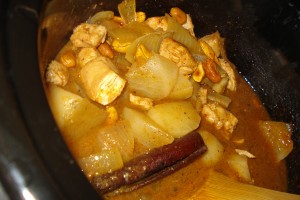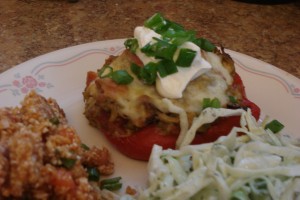I don’t have much time during the average work week to tackle culinary projects more elaborate than a sandwich, tossed salad or filet of baked fish, and so, I often spend my glimmers of down-time during the week planning for the weekend by researching recipes and stocking up on any needed groceries. That way, I can devote long lazy weekend days at home to food prep, cooking and enjoying the fruits of my labors.
There came a weekend when a particular combination of cravings, left-overs, and on-hand-ingredients (after all, the art of thrift and avoidance of wastefulness calls for using the surplus items of previous culinary projects — some items sooner than later!) left me torn between taking on a Mexican or a Thai cooking project. Mulling over this dilemma, an idea occurred to me… could there be a tasty fusion of the two where mutual flavors and ingredients crossed paths? I pondered the peculiar idea of a Thai Taco — an idea that turned out not to be so revolutionary after all! I found many recipes online for this apparent fusion favorite. In the time since, I have experimented with a few different permutations of the recipe and have arrived at the one I like best.
A few notes… I like to make a large batch of pork at a time and freeze it in batches. The pork-to-marinade ratio need not be exact, and so you don’t have to adjust for somewhat higher or lower poundage of pork. Flavor may be a bit more pronounced if less pork is used and vice versa if more. If you want to use a significantly smaller or larger amount of pork, then you may want to scale the marinade up or down.
For the mix of fixin’s, I like to use a chopped salad kit from Aldi as my base for ease of preparation. It already contains cabbage, carrots and green onions chopped small. I simply set the dressing aside for a different use and add tomatoes, peanuts and basil to the base. I only use the peppers when I have them on hand from the garden. It makes the process a bit more streamlined, especially when using pork that’s been prepared ahead of time.
SARAH’S THAI TACOS
Pork & Marinade:
3-4 lbs boneless pork
1/4 cup fresh lime juice
1/4 cup thin soy sauce
3 Tbsp honey or packed brown sugar
2 Tbsp vegetable oil or light olive oil
1 Tbsp fish sauce
1 tsp sriracha
4 cloves garlic , minced
1 tsp ground ginger
1/3 cup chopped cilantro
1/3 cup chopped green onions
Peanut Sauce:
1/4 cup peanut butter
1 tablespoon lime juice
1 tablespoon thin soy sauce
1-2 teaspoons honey
1 teaspoon ground ginger
1/2 teaspoon garlic, minced
1 teaspoon sriracha
1 teaspoon fish sauce
1/4 cup hot water
Taco Fixin’s:
tomatoes, diced
cabbage, chopped small or shredded
sweet or hot peppers, julienne
green onions, chopped
carrots, shredded
peanuts, crushed and toasted
basil, snipped thin
corn tortillas, warmed
Combine the pork and marinade ingredients in a slow cooker. Cook on high for 4 hours or low for 8 hours, until pork shreds easily with a fork.
Meanwhile prepare the peanut sauce in a liquid-tight container. Allow to sit out at room temperature and shake container occasionally to combine ingredients. If ambient temperature is too cool or peanut butter is especially thick, you may need to stir with a fork to get it smooth.
Prepare Taco Fixin’s a bit ahead of time. They can be kept separately for a “taco bar” serving style, or tossed together like a salad and then added to each taco.
Heat a non-stick skillet or grill pan over medium heat. Warm the tortillas in pan, flipping after a minute or two. Tortillas should be a little bit browned, but still pliable and not too crispy.
Fill tortillas with shredded pork and fixin’s; drizzle with peanut sauce. Enjoy!







